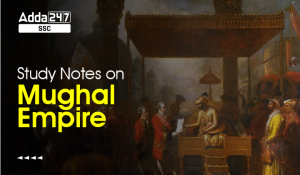The Delhi Sultanate, an Islamic Empire based in Delhi, ruled over extensive regions of South Asia for 320 years (1206–1526). The five dynasties that governed the Delhi Sultanate were the Mamluk dynasty (1206–1290), the Khalji dynasty (1290–1320), the Tughlaq dynasty (1320–1414), the Sayyid dynasty (1414–1451), and the Lodi dynasty (1451–1526).
This article provides comprehensive notes on the Delhi Sultanate, highlighting key rulers, founders, and significant facts related to the five dynasties from Medieval Indian History.
Chronological Order of Delhi Sultanate Rulers and Major Events
The table given below highlights the major Rulers and the important events happened during their reign under Delhi Sultanate.
| Dynasty | Ruler(s) | Reign | Major Events |
|---|---|---|---|
| Mamluk (Slave) | Qutb-ud-din Aibak | 1206–1210 | Founded Delhi Sultanate, constructed Qutb Minar (started) |
| Iltutmish | 1211–1236 | Completed Qutb Minar, introduced Iqta system, saved Delhi from Mongol invasion | |
| Raziya Sultana | 1236–1240 | First female ruler of Delhi Sultanate | |
| Balban | 1266–1287 | Strengthened monarchy, suppressed nobility, enforced law and order | |
| Khilji | Jalal-ud-din Khilji | 1290–1296 | Founded Khilji Dynasty |
| Alauddin Khilji | 1296–1316 | Market reforms, South India campaigns, repelled Mongols | |
| Tughlaq | Ghiyas-ud-din Tughlaq | 1320–1325 | Founded Tughlaq dynasty |
| Muhammad bin Tughlaq | 1325–1351 | Token currency experiment, capital shift to Daulatabad | |
| Firoz Shah Tughlaq | 1351–1388 | Welfare schemes, canal irrigation, architectural developments | |
| Sayyid | Khizr Khan | 1414–1421 | Founded Sayyid dynasty after Timur’s invasion |
| Muhammad Shah | 1434–1445 | Decline of central authority | |
| Lodi | Bahlul Lodi | 1451–1489 | Founded Lodi dynasty |
| Sikandar Lodi | 1489–1517 | Administrative reforms, cultural development | |
| Ibrahim Lodi | 1517–1526 | Defeated by Babur in First Battle of Panipat, marking end of Delhi Sultanate |
Importance of Studying Delhi Sultanate for Competitive Exams
Studying the Delhi Sultanate is crucial for aspirants of SSC, Railway, and various State Level Exams due to the significant role it played in shaping medieval Indian history. Here’s why:
- Frequent in MCQs: Questions related to dynasties, rulers, reforms, battles, and administrative systems often appear in static GK sections.
- Understanding Administrative Systems: Concepts like Iqta, market reforms of Alauddin Khilji, and coinage reforms help in understanding early medieval governance.
- Battle and Political History: First Battle of Panipat and Mongol invasions are frequently asked in history and polity-related sections.
- Social & Cultural Developments: Architectural achievements, introduction of Persian culture, and Indo-Islamic art are commonly tested under art & culture sections.
A solid grasp on the Delhi Sultanate can significantly improve a candidate’s score in the General Awareness or History sections of competitive exams. Prepare with timelines, key reforms, and unique features of each ruler for better retention.
The Mamluk Dynasty
In 1206, Qutubuddin Aibak liberated India from Ghazni’s control. The rulers who governed India and expanded its territories between 1206 and 1290 AD are recognized as part of the Mamluk Dynasty, also known as the Slave Dynasty. The table below lists the names of these rulers along with their respective periods of rule.
| Ruler | Period |
| Qutb-ud-din Aibak | 1206–1210 |
| Aram Shah | 1210–1211 |
| Shams-ud-din Iltutmish | 1211–1236 |
| Ruknuddin Feruz Shah | 1236 |
| Razia Sultana | 1236–1240 |
| Muizuddin Bahram | 1240–1242 |
| Alauddin Masud | 1242–1246 |
| Nasiruddin Mahmud | 1246–1266 |
| Ghiyas-ud-din Balban | 1266–1286 |
| Muiz ud din Kaiqubad | 1287–1290 |
| Kaimur | 1290 |
Let’s look at some of the important rulers of the Mamluk or Slave dynasty from a competitive exam perspective.
Qutubuddin Aibak
Qutubuddin Aibak came from the Turkistan region and he was a slave of Mohammad Ghori. Aibak ruled as a Sultan from 1206 to 1210. While playing Polo, he fell from the horse and died in 1210.
Iltutmish
Iltutmish was a slave of Aibak. He belonged to the Ilbari Turk clan of Turkistan. In 1211, Iltutmish occupied the throne of Delhi after killing Aram Shah and successfully ruled until 1236.
Construction of the Qutub Minar
Qutubuddin Aibak started construction of the Qutub Minar. However, Iltutmish completed the unfinished construction of the Qutub Minar. Iltutmish is also credited with building the Dhai Din ka Jhopra in Ajmer.
Razia Sultan
She was the first lady Sultan who ruled for three years, six months, and six days from 1236 to 1240. She appointed Jamaluddin Yakut as the highest officer of cavalry. In 1240, the feudal lord (Subedar) of Bhatinda, Ikhtiyaruddin conspired against Razia. This led to Yukut being killed and Razia imprisoned. To counter her enemies, Razia married Altunia and attempted to regain power. On 13 October 1240, both Razia and Altunia were killed by dacoits while resting under a tree near Kaithal.
Balban
Ghiyasuddin Balban ascended the throne of Delhi in 1266. He is known for his strategically organized Military Department, called Diwan-i-Ariz, for defence from the Mongols. ‘Ghiyasuddin Balban introduced the customs of ‘Sijda’ and ‘Paibos’ as normal forms of salutations to the king as a part of court etiquette.
The Khalji dynasty
The Khalji Dynasty was the second dynasty under the Delhi Sultanate. The important rulers of Khalji dynasty along with their period of rule are mentioned below.
| Rulers | Period |
| Jalal-ud-din Firoz Khilji | 1290–1296 |
| Alauddin Khilji | 1296–1316 |
| Shihabuddin Omar | 1316 |
| Qutb-ud-din Mubarak Shah | 1316–1320 |
| Khusrau Khan | 1320 |
Jalaluddin Feroz Khalji
Jalauddin Khalji (1290-1296 CE) was the first Delhi Sultan to show benevolence towards Hindus, believing the state should be based on the governed’s support. He adopted a policy of tolerance but was murdered by his son-in-law Alauddin Khalji in 1296. A
Alauddin Khalji
Alauddin Khalji (1296-1316 CE) reversed this tolerant policy, imposing harsh punishments and strict social controls. He separated religion from politics, proclaiming “Kingship knows no kinship.” Alauddin patronized poets like Amir Khusrau and defeated Mongols in several battles. His slave-general Malik Kafur led southern expeditions. Alauddin adopted the title Sikander-i-Azam and called Amir Khusrau Tuti-i-Hind. Barani’s ‘Tarikh-i-Firuz Shahi’ and Amir Khusrau’s ‘Khazain-ul-Futuh’ document his reign and conquests.
Conquest of Chittor
In January 1303, Alauddin invaded Chittor. After 7 months of siege, he captured the fort. Consequently, Rani Padmini and other women committed Jauhar instead of surrendering to Alauddin.
The Tughlaq Dynasty
The Tughlaq dynasty lasted from 1320 to nearly the end of the 14th century. The first ruler Ghazi Malik renamed himself Ghiyath al-Din Tughlaq. He is also referred to in scholarly works as Tughlak Shah.
Ghiyasuddin Tughlaq
His name was Ghazi Malik or Ghazi Beg Tuglaq. After defeating Khusrau Khan, he ascended the throne of Delhi in 1320. He became the founder of the new dynasty known as the Tughlaq dynasty. He ruled up to 1325.
Mohammad Bin Tughlaq
Mohammad Bin Tughlaq ruled from 1325 to 1351. He was smart but made some big mistakes. He tried new things like moving the capital city and making new types of money, but these ideas didn’t work out well. He was fair to everyone, even if they weren’t Muslim. A famous traveler named Ibn-Batuta visited India during this time and wrote about it.
Firoz Shah Tughlaq
After him, Firoz Shah Tughlaq became the ruler from 1351 to 1388. He tried to make everyone happy – the nobles, the army, and the religious leaders. He made some jobs pass from father to son. He also built canals and new towns. He started special offices to help poor people and to take care of slaves.
Nasiruddin Muhammad
The last Tughlaq ruler was Nasiruddin Muhammad. He ruled from 1390 to 1398. During his time, a foreign ruler named Taimur invaded India. This attack made the Delhi Sultanate very weak. After this, the Tughlaq family lost power in 1412. The big kingdom broke into smaller ones, like Malwa and Gujarat.
The list of other important rulers of the Tughlaq Dynasty is given below:
| Rulers | Period |
| Ghiyath al-Din (Ghiyasuddin) Tughluq | 1320–1325 |
| Muhammad bin Tughluq | 1325–1351 |
| Mahmud Ibn Muhammad | 1351 (March) |
| Firoz Shah Tughlaq | 1351–1388 |
| Ghiyas-ud-Din Tughluq II | 1388–1389 |
| Abu Bakr Shah | 1389–1390 |
| Nasir ud din Muhammad Shah III | 1390–1393 |
| Ala ud-din Sikandar Shah I | 1393 |
| Mahmud Nasir ud din | 1393–1394 |
| Nasir-ud-din Nusrat Shah Tughluq | 1394–1399 |
| Nasir ud din Mahmud | 1399–1412 |
Tughlaq Dynasty: Rulers And Policies Of the Tughlaq Dynasty
The Sayyid Dynasty
The Sayyid dynasty ruled the Delhi Sultanate from 1415 to 1451. Khizr Khan was the first ruler and founder of the Sayyid dynasty. In 1414, Khizr Khan captured Delhi. He ruled Delhi until 1421. His son Mubarak Khan ascended the throne of Delhi in 1421 after his father’s death and adopted the title of Mubarak Shah. He ruled for over 13 years from 1421 to 1434. His time was spent struggling against foreign enemies and internal conspirators.
| Rulers | Period |
| Khizr Khan | 1414–1421 |
| Mubarak Shah | 1421–1434 |
| Muhammad Shah | 1434–1445 |
| Alam Shah | 1445–1451 |
The Lodi Dynasty
The Lodi Dynasty belonged to the Pashtun (Afghan) Lodi tribe. Bahlul Khan Lodi founded the Lodi dynasty and was the first Pashtun ruler to rule the Delhi Sultanate. Sikander Lodi was the most prominent ruler of the Lodi Dynasty who founded Agra City. After him, Ibrahim Lodi became the last ruler of the Lodi Dynasty as well as the Delhi Sultanate.
| Rulers | Period |
| Bahlul/Bahlol Lodi | 1451–1489 |
| Sikander Lodi | 1489–1517 |
| Ibrahim Lodi | 1517–1526 |




 Reasoning Topics Asked in SSC CGL Exam L...
Reasoning Topics Asked in SSC CGL Exam L...
 Top 10 Longest Rivers in India, Largest ...
Top 10 Longest Rivers in India, Largest ...
 Mughal Empire Notes For RRB NTPC Exam 20...
Mughal Empire Notes For RRB NTPC Exam 20...


